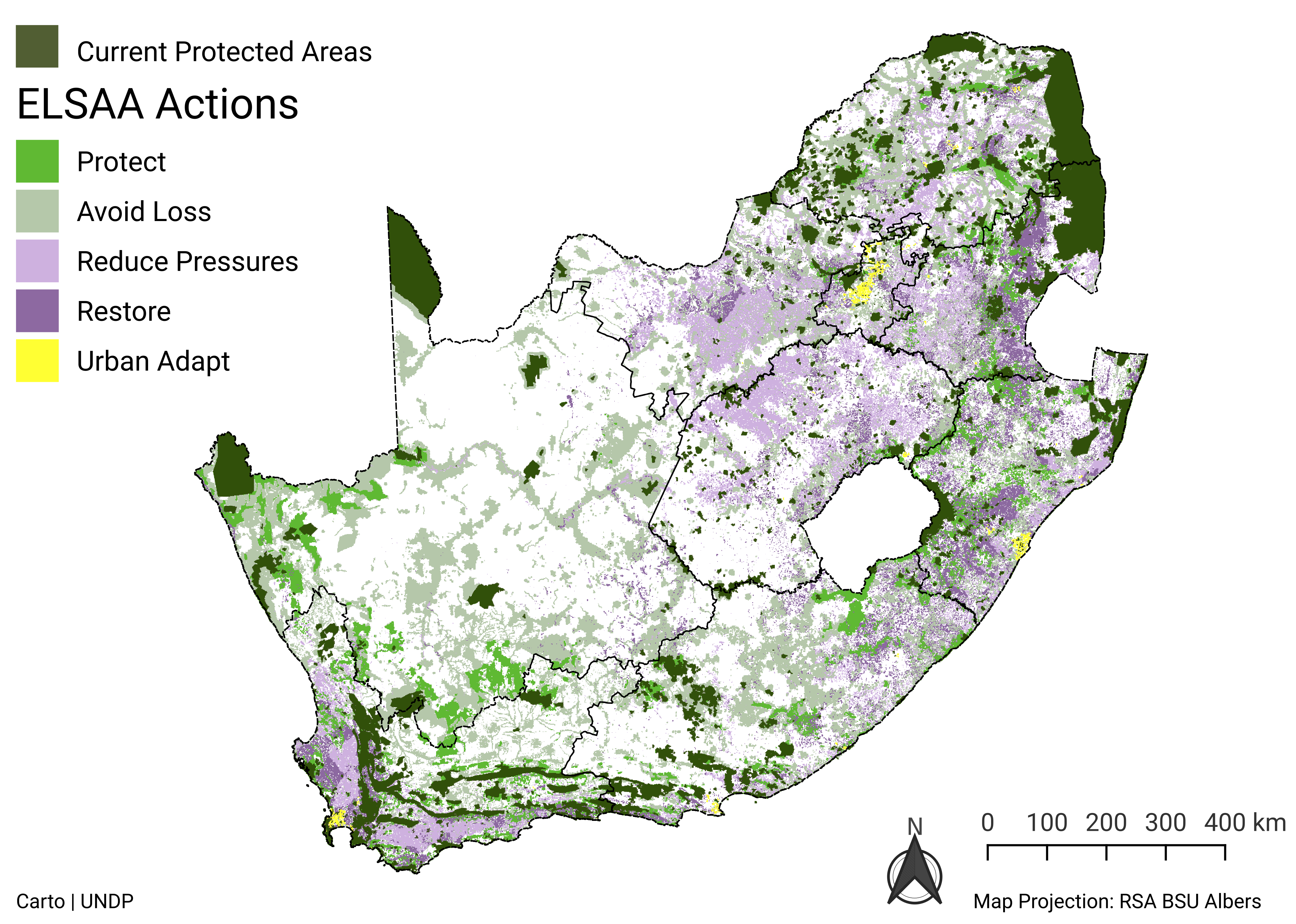
South Africa is now one of the first countries in the world to develop a spatial data tool that integrates priorities across biodiversity conservation, climate change, and sustainable development into a single action map. This comes as a result of the partnership that the United Nations Development Programme (UNDP) in South Africa through its Biodiversity Finance Initiative Project (BIOFIN), supported by Impact Observatory and the Sustainable Markets Foundation, has forged with the Department of Forestry, Fisheries and the Environment (DFFE) and the South African National Biodiversity Institute (SANBI) to map the country’s essential life support action areas (ELSAAs). These are critical places where efforts to protect, manage, and restore nature could sustain critical benefits to South Africans, including food and water security, sustainable livelihoods, disaster risk reduction, and carbon sequestration.
Since June 2021, experts in spatial data and systematic conservation planning from across South Africa have met virtually for a series of consultations to develop the country’s ELSAA map based on national priorities and the best available spatial data. The resulting map is a tool that South Africa can use to harmonize land use policies and prioritize regions to protect, avoid loss, restore, reduce pressures, and engage in ecosystem-based urban adaptation.
“DFFE has developed a Resource Mobilisation Action Plan which identifies areas where environmental fiscal measures are needed. ELSAA feeds into this work and the sector in general and will provide South Africa much-needed information in regard to where its efforts should be directed in relation to how the country manages resources, both financially and in relation to skills and capacity,” Ms Flora Mokgohloa, Deputy Director General, DFFE.
Mr. Shonisani Munzhedzi, Chief Executive Officer, SANBI notes that “the NBF has a specific target that deals with spatial planning and integrating biodiversity plans into multi-sectoral plans, hence the importance of this ELSAA project. The novel approach of the ELSAA project will assist the country to focus its efforts to achieve targets across a range of policy commitments. The policy commitments are varied and include maintaining ecosystems, restoring degraded ecological infrastructure, expanding the conservation estate, maintaining carbon stocks, and developing the wildlife economy.”
In the South African context, the ELSAA map was conceived as a “Map for Nature-Positive Action”. The primary purpose of the map will be to unlock or mobilise resources for nature-based actions that are optimised across several policy commitments. At the results-sharing meeting on 12 April, UNDP and its partners will present the final ELSAA map to relevant decision-makers and seek feedback on additional applications for the map.
“UNDP considers nature as a critical component of achieving the Sustainable Development Goals (SDGs), especially given that more than half of the SDGs depends on nature. UNDP’s key priority is to continue supporting the South African government and its partners in their efforts to achieve the SDGs by preserving the natural ecosystems that support human well-being and livelihoods,” Dr Ayodele Odusola, Resident Representative, UNDP South Africa.
South Africa is one of a group of countries, including Cambodia, Chile, Colombia, Costa Rica, the Dominican Republic, Ecuador, Haiti, Kazakhstan, Nepal, Peru, and Uganda, that are developing these ‘maps of hope’ to meet their goals related to sustainable development, climate change, and biodiversity. This exercise is one of the first of its kind in the world, notable for the live engagement of national experts and scientists to develop a map that reflects South Africa’s national priorities and realities.
The project attracted broad participation from national agencies and non-governmental organisations. This project has been made possible thanks to the financial support of Impact Observatory and the Sustainable Markets Foundation.
Categories
Archives
- janvier 2026 (1)
- décembre 2025 (2)
- novembre 2025 (5)
- octobre 2025 (6)
- septembre 2025 (2)
- août 2025 (10)
- juillet 2025 (9)
- juin 2025 (5)
- mai 2025 (8)
- avril 2025 (9)